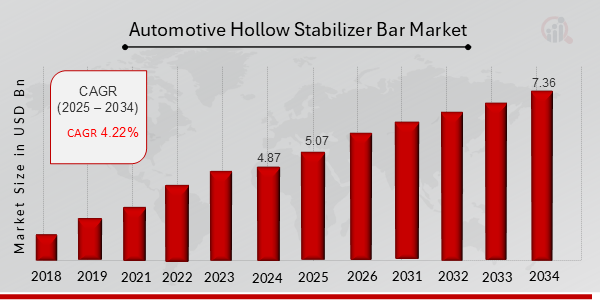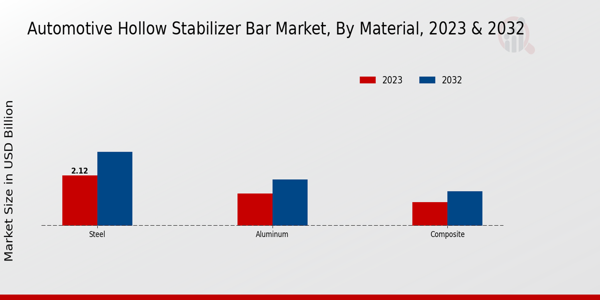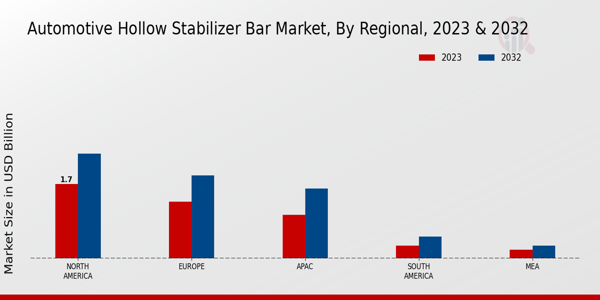Global Automotive Hollow Stabilizer Bar Market Overview
As per MRFR analysis, the Automotive Hollow Stabilizer Bar Market Size was estimated at 4.87 (USD Billion) in 2024. The Automotive Hollow Stabilizer Bar Market Industry is expected to grow from 5.07 (USD Billion) in 2025 to 7.36 (USD Billion) till 2034, at a CAGR (growth rate) is expected to be around 4.22% during the forecast period (2025 - 2034).
Key Automotive Hollow Stabilizer Bar Market Trends Highlighted
The global automotive hollow stabilizers bar market is growing significantly due to the upsurge in vehicle production worldwide and the need for improved fuel economy. With the advent of stringent emission control order, automotive manufacturers have been striving to optimize the weight of the vehicle without jeopardizing its safety or operational capabilities. As a possible substitute, hollow stabilizers bars are considered to be more efficient because they replace traditional solid bars that are substantially heavier, which enhances the general efficiency of the vehicle. Moreover, the prevailing transition to electric and hybrid vehicles also serves as a catalyst as there are special components required to augment their weight and balance configuration.
There are great opportunities in this market particularly with advances in materials and manufacturing methods. The improvement of performance characteristics of stabilizer bars by the application of advanced composites and alloys can result in more automakers’ demand as the quest for better vehicle dynamics is a constant. In addition, the upsurge of electric vehicles gives an opportunity to manufacturers to develop such solutions designed and developed specifically for these platforms which bear different weight and stability related problems. Customizable stabilizers bars for common model types present new market potential in collaboration with automobile manufacturers.
Automotive Hollow Stabilizer Bar Market Recent trends show a focus on lightweight materials and innovative engineering techniques in the automotive sector. The integration of computer-aided design and simulation tools allows for the development of stabilizer bars that meet the precise performance requirements of modern vehicles. Moreover, sustainability remains a crucial aspect, with some companies exploring recycling and eco-friendly manufacturing processes. The shift towards automation in production is also noticeable as companies seek to enhance efficiency and reduce costs. Overall, the Automotive Hollow Stabilizer Bar Market is poised for continued evolution, driven by a combination of regulatory pressures, consumer preferences, and technological advancements.

Source: Primary Research, Secondary Research, MRFR Database and Analyst Review
Automotive Hollow Stabilizer Bar Market Drivers
Increasing Demand for Lightweight Automotive Components
The demand for lightweight components in vehicles is on the rise, driven by the automotive industry's push for improved fuel efficiency and reduced emissions. As automakers seek to enhance the performance and efficiency of their vehicles, they are increasingly turning to lightweight materials for various components, including stabilizer bars. The Automotive Hollow Stabilizer Bar Market Industry is witnessing significant growth as hollow stabilizer bars provide the dual benefit of reducing overall vehicle weight while maintaining structural integrity and performance.This trend is further fueled by stringent government regulations focused on reducing carbon footprints, which necessitate the adoption of more efficient automotive technologies. Manufacturers are also investing in advanced manufacturing techniques to produce hollow stabilizer bars that meet the evolving requirements for weight savings, making them an integral part of modern vehicle design. As the automotive sector continues to prioritize eco-friendliness and performance, the hollow stabilizer bar segment is well-positioned for substantial growth, presenting ample opportunities for market participants to innovate and expand their offerings.
Rising Focus on Vehicle Stability and Safety
As consumer awareness regarding vehicle safety continues to grow, automakers are prioritizing the development and implementation of advanced systems that improve ride quality and stability. The Automotive Hollow Stabilizer Bar Market Industry is driven by the necessity for stabilizer bars that enhance vehicle handling and reduce body roll during cornering. Improved vehicle stability is not only crucial for safety purposes but also elevates the driving experience.With automakers actively investing in research and development to introduce innovative vehicle dynamics control systems, the adoption of hollow stabilizer bars has emerged as a strategic response to these safety concerns. This increasing focus on safety and performance enhancement is set to propel the demand for hollow stabilizer bars across various vehicle segments, fostering robust growth in the market.
Technological Advancements in Material Science
The continuous advancements in material science are significantly impacting the Automotive Hollow Stabilizer Bar Market Industry. Innovative materials such as advanced composites and high-strength alloys are being developed to further enhance the performance and durability of stabilizer bars. These breakthroughs not only contribute to weight reduction but also improve the overall efficacy of these components in managing vehicle dynamics. As automotive manufacturers integrate these new materials into their designs, the hollow stabilizer bar market is poised for increased growth driven by enhanced product offerings that promise superior performance and reliability.This trend reflects a broader commitment within the industry to leverage cutting-edge technology to meet changing consumer expectations and regulatory standards for vehicle performance.
Automotive Hollow Stabilizer Bar Market Segment Insights:
Automotive Hollow Stabilizer Bar Market Material Insights
The Automotive Hollow Stabilizer Bar Market, showcasing a notable valuation of 4.48 USD Billion in 2023, reflects significant growth in the Material segment, which is essential for enhancing vehicle stability and performance. Among the various materials, steel holds a majority share with a valuation of 2.12 USD Billion in 2023, growing to 3.1 USD Billion by 2032. This dominance can be attributed to steel's exceptional strength, durability, and cost-effectiveness, making it a preferred choice for automotive manufacturers. Aluminum, valued at 1.36 USD Billion in 2023 and projected to rise to 1.95 USD Billion in 2032, is gaining traction due to its lightweight properties, contributing to fuel efficiency and reduced emissions, aligning perfectly with the industry trend towards sustainability.The composite segment, though smaller, holds a valuation of 1.0 USD Billion in 2023 and is expected to reach 1.45 USD Billion by 2032. Its importance lies in its capability to combine lightweight characteristics with enhanced performance, catering to specialized applications in performance vehicles and contributing to the overall versatility of the market. Overall, the segmentation of the Automotive Hollow Stabilizer Bar Market emphasizes the imperative role of material choice, with steel continuing to dominate due to its robust nature while aluminum and composites offer significant opportunities for growth driven by trends focusing on weight reduction and performance efficiency, underscoring the diverse requirements of the automotive industry.

Source: Primary Research, Secondary Research, MRFR Database and Analyst Review
Automotive Hollow Stabilizer Bar Market Manufacturing Process Insights
In 2023, the Automotive Hollow Stabilizer Bar Market was valued at 4.48 billion USD, highlighting the significant potential for growth within the Manufacturing Process. This segment includes various techniques such as Hot Rolled, Cold Rolled, and Extrusion, each playing a crucial role in delivering high-performance stabilizer bars. Hot Rolled processes tend to dominate due to their efficiency and ability to produce high tensile strength components, which is essential for automotive applications. Cold Rolled methods offer enhanced precision and surface finish, appealing to manufacturers seeking to meet strict quality standards.Extrusion techniques also represent a vital part of the market, providing versatility in design and weight reduction, contributing to fuel efficiency and overall vehicle performance. The market growth is driven by increasing vehicle production and rising demand for lightweight components, although challenges may arise from fluctuating raw material prices and technological advancements. Overall, the segmentation within the Manufacturing Process underlines both opportunities and competitive dynamics, reflecting the importance and innovation prevalent in the Automotive Hollow Stabilizer Bar Market industry.
Automotive Hollow Stabilizer Bar Market End Use Application Insights
The Automotive Hollow Stabilizer Bar Market revolves around diverse End Use Applications, with each segment playing a critical role in the industry's overall dynamics. In 2023, the market displays significant engagement across various vehicle types, notably Passenger Vehicles, Commercial Vehicles, Light Trucks, and Heavy Trucks. Passenger Vehicles account for a major portion of the market, reflecting the growing consumer demand for enhanced vehicle stability and control. Commercial Vehicles also hold substantial value, driven by an increase in logistics and transportation needs, where the demand for reliable stabilizer bars ensures optimal vehicle performance under varying loads.The Light Trucks segment emerges as significant due to their versatility and popularity in both personal and commercial use, requiring robust stabilizer solutions to manage ride quality and handling. Heavy Trucks dominate the market by offering substantial stability during the transport of heavy goods, which is crucial for operational safety and efficiency. Trends toward lightweight materials and vehicle safety enhancements are driving demand across these applications. Challenges such as cost pressures and the need for innovation necessitate strategic adaptations, while growing opportunities lie in advancing technology and sustainability practices within the automotive sector, as evidenced by the overall Automotive Hollow Stabilizer Bar Market revenue, driven by evolving market growth and segmentation.
Automotive Hollow Stabilizer Bar Market Size Insights
The Automotive Hollow Stabilizer Bar Market, valued at 4.48 USD Billion in 2023, is witnessing significant progress with robust market growth projected towards 2032. This market segmentation effectively divides into Small, Medium, and Large categories, each contributing markedly to the overall dynamics. The Small segment generally holds a majority share due to the growing demand for compact vehicles, which emphasize lightweight components that enhance fuel efficiency. Furthermore, the Medium segment remains significant as it caters effectively to the broad industry of sedans and SUVs, balancing performance and comfort.Meanwhile, the Large segment thrives in the commercial vehicle sector, where durability and structural integrity are paramount, thereby sustaining its considerable market position. As the industry gears towards advancements in automotive engineering and consumer preferences shift towards efficiency and sustainability, these segmentation trends highlight the Automotive Hollow Stabilizer Bar Market's statistics and reveal growth drivers, market challenges, and opportunities lurking within the increasing automotive sector.
Automotive Hollow Stabilizer Bar Market Regional Insights
The Regional segment of the Automotive Hollow Stabilizer Bar Market shows promising growth, with the total market expected to reach 4.48 USD Billion in 2023 and 6.5 USD Billion by 2032. North America holds a significant position, valued at 1.7 USD Billion in 2023, and it is projected to rise to 2.4 USD Billion by 2032, indicating its dominance in the market due to strong automotive production and consumer demand. Europe follows with a valuation of 1.3 USD Billion in 2023, growing to 1.9 USD Billion by 2032, driven by advancements in vehicle technology and increasing regulations for safer vehicles.The APAC region, valued at 1.0 USD Billion in 2023, is expected to reach 1.6 USD Billion by 2032, benefiting from rapid industrialization and a growing consumer base for automobiles. In contrast, South America, with a market value of 0.3 USD Billion in 2023, is anticipated to reach 0.5 USD Billion by 2032, reflecting a relatively smaller market presence. Similarly, the MEA region, valued at 0.2 USD Billion in 2023, is expected to increase to 0.3 USD Billion by 2032, influenced by developing infrastructure and rising automotive sales. Each region offers distinct opportunities and challenges, with the Automotive Hollow Stabilizer Bar Market revenue expanding as innovation and regional demands evolve.

Source: Primary Research, Secondary Research, MRFR Database and Analyst Review
Automotive Hollow Stabilizer Bar Market Key Players and Competitive Insights:
The Automotive Hollow Stabilizer Bar Market is characterized by a dynamic competitive landscape driven by the increasing demand for lightweight yet durable components in vehicle manufacturing. The shift toward enhanced fuel efficiency and improved vehicle handling solidifies the importance of stabilizer bars in automotive design. This market is notable for the presence of key players who are leveraging innovative technologies and materials to meet stringent industry standards. The competitive environment is increasingly influenced by factors such as advancements in production techniques, the incorporation of sustainable practices, and the shift towards electric vehicles, which necessitates a reevaluation of vehicle chassis components. Market players are focusing on strategic partnerships, mergers, and acquisitions to strengthen their positioning and expand their market share in this rapidly evolving sector.Mubea holds a prominent position in the Automotive Hollow Stabilizer Bar Market, recognized for its strong engineering capabilities and commitment to high-quality manufacturing. The company has developed a reputation for producing lightweight stabilizer bars that enhance vehicle performance without compromising safety or reliability. Mubea's focus on research and development allows it to stay ahead of industry trends and regulatory requirements, thus ensuring that its products meet the specific needs of automotive manufacturers.
Additionally, the company has established a robust supply chain and distribution network that ensures timely delivery and an efficient response to market demands. Mubea's innovative approach to design and production not only addresses performance enhancement but also aligns with the industry's growing environmental sustainability goals, making it a leading player in this competitive market.Hanon Systems is also a significant contributor to the Automotive Hollow Stabilizer Bar Market, leveraging its expertise in thermal and energy management solutions. The company's focus on lightweight materials and advanced engineering practices has positioned it as a key player in designing stabilizer bars that improve vehicle dynamics and user experience. Hanon Systems emphasizes technological innovation and continuously invests in R&D to enhance the performance characteristics of its products. With a strong emphasis on meeting the shifting preferences towards sustainability and efficiency, Hanon Systems is adept at offering solutions that cater to the evolving automotive landscape, including the growing electric vehicle sector. Its commitment to operational excellence and strategic partnerships has enabled Hanon Systems to bolster its market presence and fulfill the needs of automotive OEMs seeking reliable and high-performance stabilizer bars.
Key Companies in the Automotive Hollow Stabilizer Bar Market Include:
- Mubea
- Hanon Systems
- Magna International
- ZF Friedrichshafen
- Valeo
- Marugo Rubber Industries
- BWI Group
- Adient
- Jiangsu Jinlong Technology
- Kongsberg Gruppen
- Schaeffler
- McPherson
- Thyssenkrupp
- Tenneco
- Dura Automotive Systems
Automotive Hollow Stabilizer Bar Market Industry Developments
Recent developments in the Automotive Hollow Stabilizer Bar Market have been noteworthy, with several companies making strategic moves. Mubea has been focusing on technological innovations to enhance the performance and efficiency of hollow stabilizer bars, which is vital for automotive safety and handling. Hanon Systems and Valeo are also investing in advanced materials, aiming to improve the weight-to-strength ratio in their products. Magna International has reported significant growth in its market valuation, driven by increased demand for lighter and more efficient components, thus enhancing its competitive position. ZF Friedrichshafen and Schaeffler are exploring collaborative partnerships to accelerate product development and expand their market reach. Recent merger activities have seen BWI Group consolidating its position by acquiring smaller firms, enabling a wider range of offerings. Additionally, Thyssenkrupp has announced plans for expansion in the Asia-Pacific region, underlining the growing significance of emerging markets. The current market dynamics reflect a trend toward innovation and collaboration among key players, such as Adient and Tenneco, as they adapt to changing consumer needs and regulatory standards in the automotive industry.
Automotive Hollow Stabilizer Bar Market Segmentation Insights
-
Automotive Hollow Stabilizer Bar Market Material Outlook
-
Automotive Hollow Stabilizer Bar Market Manufacturing Process Outlook
- Hot Rolled
- Cold Rolled
- Extrusion
- Other
-
Automotive Hollow Stabilizer Bar Market End Use Application Outlook
- Passenger Vehicles
- Commercial Vehicles
- Light Trucks
- Heavy Trucks
-
Automotive Hollow Stabilizer Bar Market Size Outlook
-
Automotive Hollow Stabilizer Bar Market Regional Outlook
-
North America
-
Europe
-
South America
-
Asia Pacific
-
Middle East and Africa
| Report Attribute/Metric |
Details |
|
Market Size 2024
|
4.87 (USD Billion)
|
|
Market Size 2025
|
5.07 (USD Billion)
|
|
Market Size 2034
|
7.36 (USD Billion)
|
|
Compound Annual Growth Rate (CAGR)
|
4.22% (2025 - 2034)
|
|
Report Coverage
|
Revenue Forecast, Competitive Landscape, Growth Factors, and Trends
|
|
Base Year
|
2024
|
|
Market Forecast Period
|
2025 - 2034
|
|
Historical Data
|
2019 - 2023
|
| Market Forecast Units |
USD Billion |
| Key Companies Profiled |
Mubea, Hanon Systems, Magna International, ZF Friedrichshafen, Valeo, Marugo Rubber Industries, BWI Group, Adient, Jiangsu Jinlong Technology, Kongsberg Gruppen, Schaeffler, McPherson, Thyssenkrupp, Tenneco, Dura Automotive Systems |
| Segments Covered |
Material, Manufacturing Process, End Use Application, Size, Regional |
| Key Market Opportunities |
Rising demand for lightweight vehicles, Increased electrification of vehicles, Expansion of developing automotive markets, Technological advancements in materials, Growing focus on vehicle safety features |
| Key Market Dynamics |
growing vehicle production, increasing consumer demand, lightweight material adoption, stringent emission regulations, expanding electric vehicle market |
| Countries Covered |
North America, Europe, APAC, South America, MEA |
Frequently Asked Questions (FAQ) :
The market is expected to reach a value of 7.36 USD Billion by 2034.
In 2024, the market was valued at 4.87 USD Billion.
The expected CAGR for the market during this period is 4.22%.
North America has the largest market share, valued at 1.7 USD Billion in 2023.
The Steel segment is projected to reach a market value of 3.1 USD Billion by 2032.
Key players include Mubea, Hanon Systems, Magna International, and ZF Friedrichshafen.
The Aluminum segment is expected to be valued at 1.95 USD Billion by 2032.
The APAC region is projected to grow to a market value of 1.6 USD Billion by 2032.
The Composite segment is expected to reach a market value of 1.45 USD Billion by 2032.
The South America region is anticipated to reach a value of 0.5 USD Billion by 2032.

















